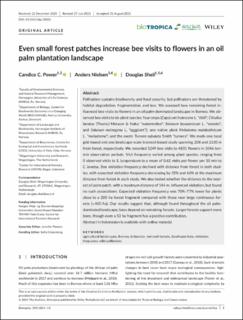| dc.description.abstract | Pollination sustains biodiversity and food security, but pollinators are threatened by habitat degradation, fragmentation, and loss. We assessed how remaining forest influenced bee visits to flowers in an oil palm-dominated landscape in Borneo. We observed bee visits to six plant species: four crops (Capsicum frutescens L. “chili”; Citrullus lanatus (Thunb.) Matsum & Nakai “watermelon”; Solanum lycopersicum L. “tomato”; and Solanum melongena L. “eggplant”); one native plant Melastoma malabathricum L. “melastome”; and the exotic Turnera subulata Smith “turnera”. We made one local grid-based and one landscape-scale transect-based study spanning 208 and 2130 m from forest, respectively. We recorded 1249 bee visits to 4831 flowers in 1046 ten-min observation periods. Visit frequency varied among plant species, ranging from 0 observed visits to S. lycopersicum to a mean of 0.62 visits per flower per 10 min to C. lanatus. Bee visitation frequency declined with distance from forest in both studies, with expected visitation frequency decreasing by 55% and 66% at the maximum distance from forest in each study. We also tested whether the distance to the nearest oil palm patch, with a maximum distance of 144 m, influenced visitation, but found no such associations. Expected visitation frequency was 70%–77% lower for plants close to a 200 ha forest fragment compared with those near large continuous forests (>400 ha). Our results suggest that, although found throughout the oil palm-dominated landscape, bees depend on remaining forests. Larger forests support more bees, though even a 50 ha fragment has a positive contribution. Abstract in Indonesian is available with online material. | en_US |

